https://doi.org/10.1140/epja/s10050-024-01444-x
Regular Article –Theoretical Physics
Competition of decay modes for  and
and  superheavy nuclei
superheavy nuclei
1
School of Science, Xinjiang Institute of Technology, 843100, Aksu, China
2
School of Nuclear Science and Technology, Lanzhou University, 730000, Lanzhou, China
3
Frontiers Science Center for Rare Isotopes, Lanzhou University, 730000, Lanzhou, China
4
School of Physics, Xi’an Jiaotong University, 710049, Xi’an, China
a
zhyu@lzu.edu.cn
b
zhanghf@xjtu.edu.cn
Received:
28
September
2024
Accepted:
24
October
2024
Published online:
18
November
2024
Synthesis of new elements with  is currently a forefront issue in modern nuclear physics. The central question then arises as to the stability and decay properties of these new elements. In this study, the competition between
is currently a forefront issue in modern nuclear physics. The central question then arises as to the stability and decay properties of these new elements. In this study, the competition between  -decay, spontaneous fission, cluster radioactivity, and
-decay, spontaneous fission, cluster radioactivity, and  -decay in the isotopic chains of
-decay in the isotopic chains of  and
and  was investigated using the finite-range droplet model (FRDM) and Weizsäcker -Skyrme model (WS4). The Royer formula, Karpov formula, Universal Decay Law, and Sobhani formula were applied to analyze each respective decay mode. It was found that cluster radioactivity and
was investigated using the finite-range droplet model (FRDM) and Weizsäcker -Skyrme model (WS4). The Royer formula, Karpov formula, Universal Decay Law, and Sobhani formula were applied to analyze each respective decay mode. It was found that cluster radioactivity and  -decay is at a disadvantage in these isotopic chains, with
-decay is at a disadvantage in these isotopic chains, with  -decay and SF being the dominant decay modes. For nuclei with longer half-lives for the dominant decay modes,
-decay and SF being the dominant decay modes. For nuclei with longer half-lives for the dominant decay modes,  -decay tends to be the most prevalent.
-decay tends to be the most prevalent.  is a candidate for the neutron magic number based on WS4 and FRDM. In addition, the generalized liquid drop model with corrections for surface diffuseness effects was employed to study
is a candidate for the neutron magic number based on WS4 and FRDM. In addition, the generalized liquid drop model with corrections for surface diffuseness effects was employed to study  -decay across four different sets of mass models: FRDM, WS4, Koura–Tachibana–Uno–Yamada (KTUY) mass formula, and Niu2022. The calculation of
-decay across four different sets of mass models: FRDM, WS4, Koura–Tachibana–Uno–Yamada (KTUY) mass formula, and Niu2022. The calculation of  -decay half-lives was further optimized through the use of the radial basis function network.
-decay half-lives was further optimized through the use of the radial basis function network.
Copyright comment Springer Nature or its licensor (e.g. a society or other partner) holds exclusive rights to this article under a publishing agreement with the author(s) or other rightsholder(s); author self-archiving of the accepted manuscript version of this article is solely governed by the terms of such publishing agreement and applicable law.
© The Author(s), under exclusive licence to Società Italiana di Fisica and Springer-Verlag GmbH Germany, part of Springer Nature 2024
Springer Nature or its licensor (e.g. a society or other partner) holds exclusive rights to this article under a publishing agreement with the author(s) or other rightsholder(s); author self-archiving of the accepted manuscript version of this article is solely governed by the terms of such publishing agreement and applicable law.





